“Global challenge program” projects themed on preventing zoonosis: developing One Health core competences in medical students at SJTU
-
Qinqin Hu
, Xiaoxi Zhang
, Lefei Han
, Xiangwei Li
, Xuechen Yang
and Zhaojun Wang
Abstract
Objectives
To develop One Health (OH) core competencies in medical students, Shanghai Jiao Tong University has conducted an OH practice project named the “Global Challenge Program” (GCP) for three years. This study aims to understand the outcomes and challenges of the pilot projects, thereby providing evidences to support the expansion of One Health education program on a larger scale.
Methods
We conducted a questionnaire survey to a purposive sample of 48 participants who were involved in GCP projects. A questionnaire was designed to assess the effect of GCP projects on improving the core competencies of OH professionals. It consists of 32 questions divided into four categories: basic information, overall assessment, communication skills, and interdisciplinary collaboration. Statistical analysis was conducted and reported based on the data collected from the survey.
Results
A total of 42 students (87.5 % of 48 participants) completed the follow-up survey. Among them, 64.3 % perceived a significant improvement in their understanding of the OH concept and approach after participating in the GCP projects. Benefiting from the communication opportunities offered by the GCP projects, 24.0 % and 49.0 % of the students reported significant and moderate improvement in their international communication abilities, respectively. In addition, 74 .0% of the students noted that the GCP projects greatly enhanced their capabilities in interdisciplinary cooperation and systematic thinking in addressing complex health issues.
Conclusions
The GCP project has served as a pilot initiative for participatory OH education, contributing to the development of OH core competencies in medical students, particularly in systems thinking, international communication, and interdisciplinary collaboration. However, generalizing the experience of the pilot project to a large-scale education program for medical students requires careful revisit of the gaps of resources and talents in curriculum building and project operation.
Introduction
The recent COVID-19 pandemic, the environmental crisis, and obstacles to achieving the United Nations (UN) Sustainable Development Goals have once again underscored the importance of adopting the One Health (OH) approach to address complex health issues [1]. As defined by the One Health High Level Expert Panel (OHHLEP), OH is an integrated, unifying approach that balances and optimizes the health of people, animals, and ecosystems sustainably. It emphasizes interdisciplinary, intersectoral, and cross-domain collaboration at local, regional, and global levels to foster well-being and tackle threats to health and ecosystems [2–5]. In advancing the implementation of OH, the cultivation of high-level professionals possessing interdisciplinary, collaborative, and systems thinking capabilities, serves as a crucial step [6]. Meanwhile, the education program is also in great need of disseminating techniques and knowledge in facilitating the application of OH in practical scenarios [7, 8]. Educational institutions should support government and community efforts by initiating formal frameworks to teach OH principles and approaches so that they can be easily applied in a practical setting [9, 10]. It advocates that OH education needs to include not only the fields of human, animal, and environmental health but also social sciences, economics, laws, etc. [11]. However, the holistic and inclusive perspectives of OH pose challenges in academic training for OH [12, 13].
In 2016, Frankson et al. reported core competency domains of OH training: management, communication and informatics, values and ethics, leadership, teams and collaboration, roles and responsibilities, and systems thinking [14]. These domains have been extensively applied in academic settings to develop education programs for OH professionals. Currently, an increasing number of academic institutions, including those in human medicine, veterinary medicine, agricultural science, etc., are offering undergraduate and post-graduate programs in OH. These programs largely align with the core competency domains and have been reviewed by Togami et al. and Rocheleau et al. [15, 16]. For example, the University of Melbourne has offered OH courses early in undergraduate programs to enhance undergraduates’ abilities in transdisciplinary thinking and holistic approaches. This is achieved through the introduction of theoretical concepts of OH, case studies, collaborative group-based active learning activities, and presentations by a diverse range of cross-disciplinary guest experts [17]. Another study systematically analyzed the gaps in the growing trend of OH education, recommending to train future practitioners and suggesting that communication training should be further emphasized and integrated into all OH degree programs, which would cultivate professionals proficient in communicating with academics across various disciplines, as well as policymakers and the public in diverse cultural settings [12]. Moreover, OH education programs should continue to prioritize teaching through practical fieldwork [18, 19], which brings about benefits in developing cultural competencies and collaboration among OH professionals in multisectoral and interdisciplinary settings in real-world scenarios [20–23].
In China, OH education programs started relatively late but have developed rapidly [24]. Institutions like Shanghai Jiao Tong University (SJTU), Sun Yat-sen University, Wuhan University, Peking University, etc., have introduced foundational OH courses, including theoretical connotations and high-level academic seminars. The progressively enriched and systematic course content, along with specialized lectures, have helped students build a relatively comprehensive OH knowledge framework. However, the lack of interdisciplinary communication and on-site practical experience in these training programs is the primary challenge that needs to be addressed, as it hampers the development of core competencies for OH students or medical students.
To bridge the gap in OH education programs, Shanghai Jiao Tong University (SJTU) has integrated practical project modules into the existing training programs to provide postgraduates and undergraduates with opportunities to apply OH theories and approaches in real-world settings. Since 2021, Shanghai Jiao Tong University School of Medicine-Chinese Center for Tropical Diseases Research, School of Global Health (SGH) and Chinese Centers for Disease Control and Prevention (CDC) National Institute of Parasitic Diseases have been co-organizing the annual “Global Challenge Program” practice projects (referred to as GCP). The GCP projects focus on field practices for the effective prevention and control of zoonotic diseases, such as schistosomiasis and malaria. We hypothesized that the GCP projects could enhance OH core competencies among medical students at SJTU, particularly in systems thinking, international communication, and interdisciplinary collaboration. In this study, we first introduced how GCP projects were designed and implemented to cultivate core competencies through theoretical learning and practical research. Then, we presented insights based on a questionnaire survey of participants with prior experience in GCP projects, aiming at gathering information on the effectiveness and challenges of GCP projects and informing future expansion of OH education programs for medical students.
Materials and methods
Implementation framework of the GCP projects
Figure 1 illustrates the implementation framework of GCP projects. It comprises three modules: student recruitment, project design, and project implementation.
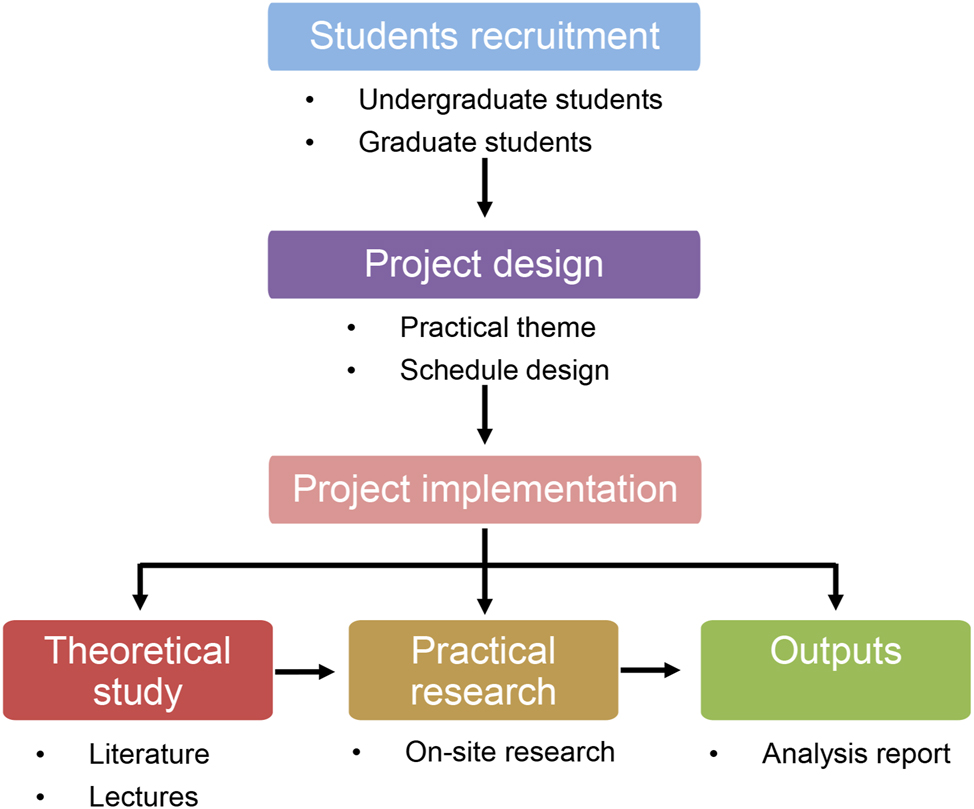
The implementation frameworks of GCP projects. The GCP projects start with student recruitment and project design. The implementation of GCP projects typically involves three modules: theoretical study, practical research, and outputs.
Participants in the GCP projects are recruited from undergraduate and graduate students at SJTU with diverse academic backgrounds, including environmental science, public health, pharmacy, management, and other fields. The counterpart implementers are responsible for recruiting participants from the local area.
Each year, GCP projects focus on translating and applying China’s experience in the prevention and control of zoonotic diseases. The schedules for these projects are carefully designed around specific themes. Table 1 provides an overview of the GCP projects from 2021 to 2023.
The general information of the GCP projects from 2021 to 2023.
| Year | Theme | Disease prevented | Event format | On-site practice location |
|---|---|---|---|---|
| 2021 | Research on the applicability of Chinese experience in blocking the transmission of Mekong schistosomiasis | Schistosomiasis | Both online and on-site | Jiangxi Province, China |
| 2022 | Malaria-free China, supporting malaria-free Africa: A study on the translation of China’s anti-malaria experience to Africa. | Malaria | Both online and on-site | Yunnan Province, China |
| 2023 | Feasibility study on the translation of China’s anti-malaria experience to Southeast Asia. | Malaria | Both online and on-site | Zhejiang Province, China; Savannakhet Province, Laos |
The implementation of GCP projects usually includes three components: theoretical studies, practical research, and outputs (Figure 1). The projects generally start with literature review and lecture learning to improve the participating students’ theoretical knowledge. This is followed by on-site practical research, where students have the opportunity to apply theoretical knowledge in real-world settings. Due to the global COVID-19 pandemic, the on-site activities for the GCP-2021 and GCP-2022 projects were carried out within China, while field visits were conducted both domestically and internationally for the GCP-2023 project. Finally, based on theoretical study and local practical research, participating students compile analysis reports and summarize their practical experiences.
Evaluation of the GCP projects
To evaluate the effectiveness in the improvement of the OH core competitiveness of students from GCP projects, 48 participating SJTU students who participated in the projects over the past three years were invited to complete an online questionnaire survey (Supporting Information). The questionnaire consists of 32 questions divided into four aspects: basic information, overall assessment of the project, assessment of communication skills, and interdisciplinary collaboration (Supporting Information). The survey results were statistically analyzed using software like Excel and subjected to descriptive statistical analysis.
Results
Demographic and background information
From 2021 to 2023, a total of 152 participants, including teachers and students from China and abroad, were involved in the GCP projects. Among them, 84 were students (48 from SJTU and 36 from other countries) and 68 were teachers (47 from SJTU and 21 from other countries). The teacher-student ratio was 1:1.24. The GCP project attracted participants from diverse international backgrounds, as evidenced by the consistent participation of non-Chinese teachers and students each year (Figure 2A). The average proportion of non-Chinese teachers and students were 30.8 % (21/68) and 42.8 % (36/84), respectively. Such a diverse composition of personnel provided the participants with the opportunity for a clash and a broad exchange of ideas. The number of SJTU students in the GCP projects increased from 12 in 2021 to 20 in 2023 (Figure 2B). In particular, the number of undergraduate students showed a seven-fold increase, from only 2 in 2021 to 14 in 2023, aligning with the concept that OH education and practice should be promoted early in students’ academic study [14, 17].
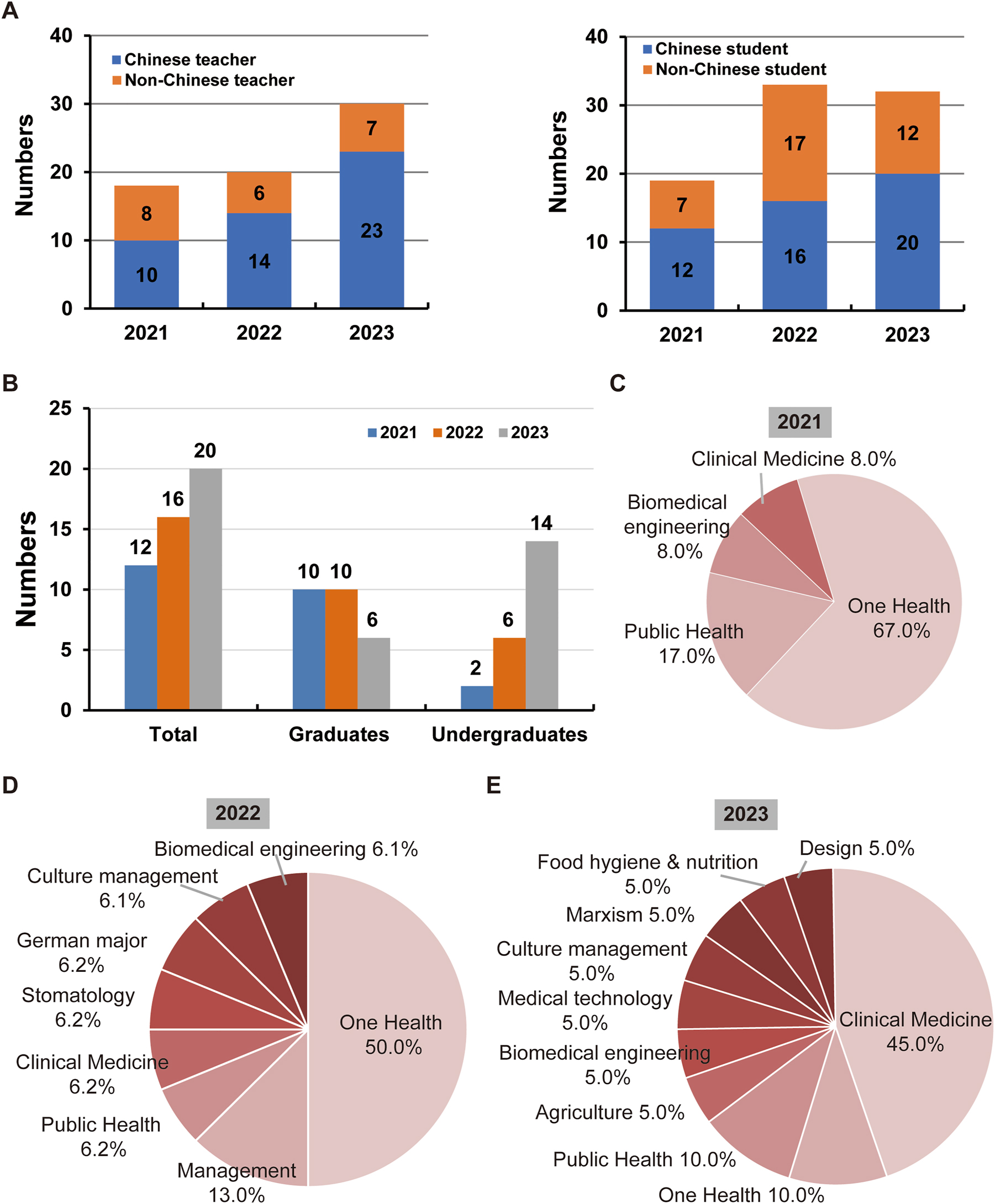
The statistics and analysis of participants’ information. (A) The numbers of Chinese and non-Chinese teachers and students in GCP-2021, GCP-2022, and GCP-2023. (B) The numbers of graduates and undergraduates from SJTU students in GCP-2021, GCP-2022, and GCP-2023. (C–E) The disciplinary background of the participating SJTU students in GCP-2021, GCP-2022, and GCP-2023.
We also analyzed the majors of the participants in the GCP projects and found a notable growth in the diversity of their academic backgrounds (Figure 2C–E). In the GCP-2021 project, 67.0 % of the students majored in OH at SGH, SJTU. The remaining one-third of the students majored in basic bioscience or medical disciplines, such as public health, biomedical engineering, and clinical medicine (Figure 2C). In the GCP-2022 project, 50.0 % of students majored in OH, while the other 50.0 % came from seven different majors, including natural sciences such as public health, biomedical engineering, and clinical medicine, and humanities such as management and culture management (Figure 2D). In 2023, SJTU students from 10 different majors participated in the GCP project. It is noteworthy that students majoring in clinical medicine have replaced those in OH as the predominant component, comprising nearly 50.0 % of the participants. The remaining portion included students from OH, public health, biomedical engineering, medical technology, agriculture, food hygiene & nutrition, culture management, Marxism, and design (Figure 2E). With the broader inclusion of students from multiple academic backgrounds, the diverse characteristics of OH were fully exemplified in the GCP-2023 project.
Implementation of GCP projects
Taking GCP-2023 as an example, the implementation and outcomes of GCP projects are presented in Table 2. In the theoretical study section, participants distilled experiences in malaria control and explored pathways for translating these experiences by reviewing 164 pieces of literature. Additionally, 15 lectures were conducted by 21 experts from eight countries to enhance participants’ proficiency in implementation research and practical investigation. Furthermore, participants engaged in discussions with experts from domestic and international organizations, as well as local teachers and students, to deepen their understanding and visualize theoretical knowledge on malaria elimination in China and around the globe.
The implementation and outcomes of the GCP-2023 project.
| Process | Outcome | |
|---|---|---|
| Theoretical study | Literature review | Reviewed a total of 164 literatures |
| Summarized distilled experiences of malaria control | ||
| Explored pathways for the malaria control experience translation | ||
| Lecture learning | 15 lectures of 21 experts from eight different countries | |
| Four themes: Implementation research, malaria elimination globally, experience from malaria elimination in China, and practical research methods | ||
| Discussion with experts | Online and offline discussions with experts from international organizations and Laos’ teachers and students | |
| Practical research | Grassroot research | Yiwu City, Zhejiang Province, China: Visiting local hospitals and CDC |
| Savannakhet Province, Laos: Visiting the local health department and the malaria unit | ||
| On-site industrial research | Investigated the population’s knowledge of malaria in Yiwu Trade Center through questionnaires | |
| Investigated the malaria control knowledge of villagers in Nong District in Savannakhet through questionnaires and interviews | ||
| Collaboration with local institutions | Emphasized the local prevention and control system of anti-malaria by investigating the local CDC | |
| Output | One report | Finished one report on “imported malaria control strategies in China” |
| Two research proposals | Finished one proposal titled “malaria elimination in Laos: Malaria surveillance and reporting for mobile and migrant-related populations” | |
| Finished one proposal titled “Laos’ malaria elimination against the Savannakhet patrol army” | ||
| “1-3-7+X” malaria control model | Proposed “1-3-7+X” grassroots malaria control model based on the local situation | |
To facilitate a thorough understanding of anti-malaria measures among participants, the GCP-2023 project conducted “point-line-surface” practice activities. At the “surface” level, the participants visited local authorities in malaria prevention and control, including the CDC of Yiwu City in Zhejiang Province, China, as well as the health department of Savannakhet Province, Laos, to gain a comprehensive understanding of the anti-malaria network and procedures. At the “line” level, participants engaged in key informant interviews with frontline clinical doctors in hospitals in Yiwu or village health clinics in Savannakhet, with key attention paid to the diagnosis and treatment of malaria, reporting procedures, and current challenges. At the “point” level, participants conducted an on-site field research, gathering residents’ understanding of malaria through questionnaire surveys and analyzing the potential risks of malaria infection in the area. Based on the investigation results, participants summarized the main challenges facing malaria elimination in the region of Laos, including a suitable natural environment for malaria transmission, inadequate healthcare facilities and resources, residents’ low awareness of malaria prevention, and frequent population flow.
Combining theoretical study with the on-site field research on malaria prevention and control, participants completed project reports (one report, two proposals, and one model) and provided recommendations for preventing imported malaria and combating malaria in Southeast Asia (Table 2).
Participants’ feedback on GCP projects
A total of 42 out of 48 students completed the survey with a response rate of 87.5 %, wherein three of them participated in the GCP program twice. The questionnaire covered three aspects apart from basic information, including overall assessment, communication skills, and interdisciplinary collaboration.
Overall assessment
In the section on overall assessment, the GCP projects were evaluated based on the students’ recognition and acceptance of OH concepts and approaches before and after participating in the projects. As shown in Figure 3A, more than two-thirds of the students (69.0 %) had not participated in any OH practical activities before the GCP projects. The remaining students with prior experience in other OH practical activities all majored in OH from SGH of SJTU. Generally, the majority of the students had little knowledge about the OH concept before joining the GCP project, as half (21 out of 42) of the students were not familiar or totally unfamiliar with OH (Figure 3B). After the GCP projects, the students’ recognition and acceptance of OH were significantly improved. About 64.3 % (27 out of 42) and 35.7 % (15 out of 42) of the students, respectively, believed that the OH concept and approach could have a very positive and positive impact in preventing emerging and re-emerging infectious diseases (Figure 3C). Almost all the students (41 out of 42) expressed their willingness to spread the OH concept. Similarly, as shown in Figure 3D, 64.3 % (27 out of 42) and 35.7 % (15 out of 42) of the students, respectively, felt that their recognition of the OH concept and approach had improved after the GCP projects significantly and moderately.
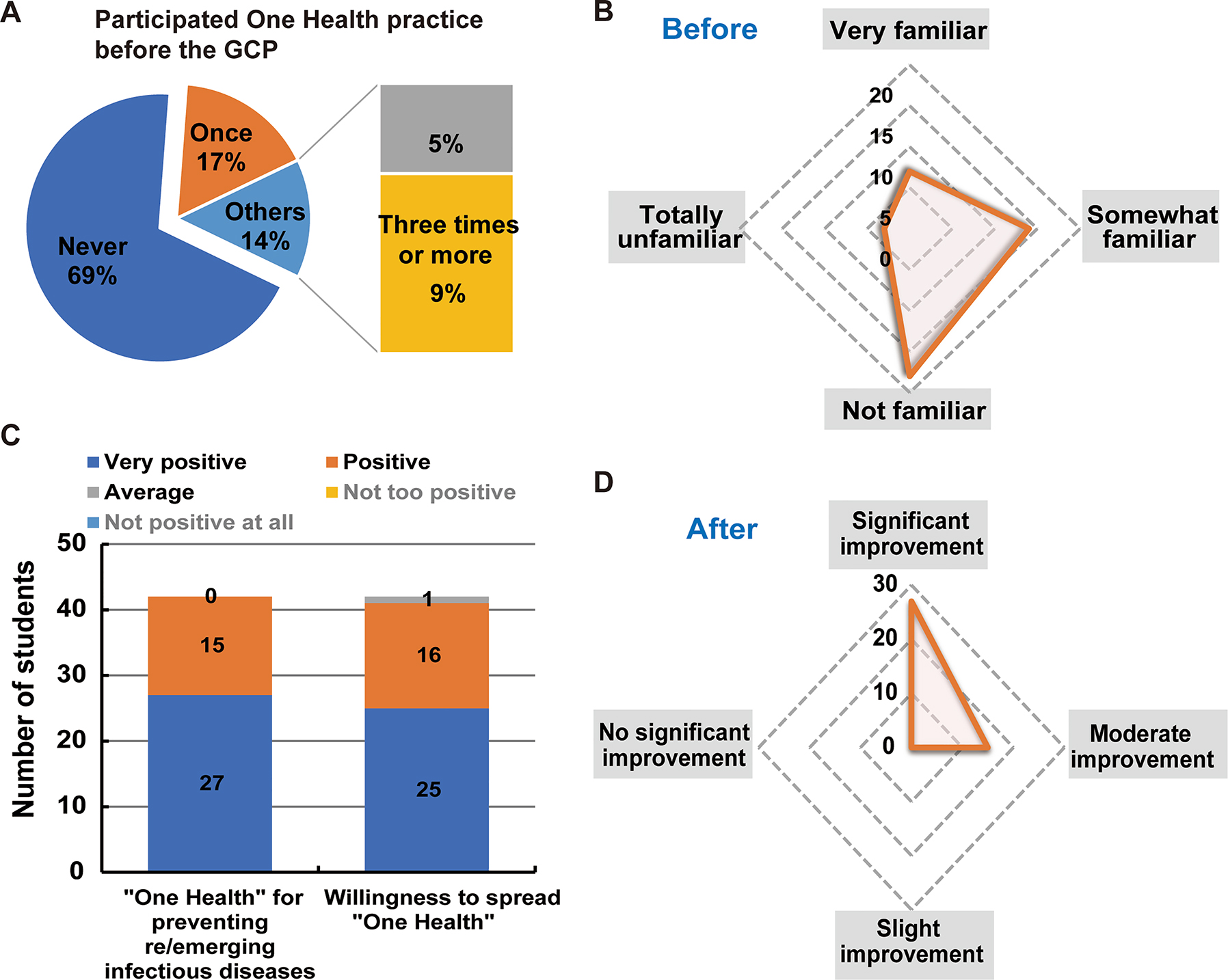
The overall evaluation of the GCP projects in 2021–2023. (A) The experience in OH practice of the interviewed students. The percentage indicates the proportion of students who chose the corresponding option among all students. (B) The recognition of OH concepts and approaches among the students before participating in the GCP projects. The unit of the radar map represents the number of students who selected the corresponding option. (C) The acceptance of OH concepts and approaches among students after participating in the GCP projects. (D) The recognition of OH concepts and approaches among students after participating in the GCP projects. The unit of the radar map represents the number of students who selected the corresponding option.
Communication skills
In the section on communication skills, about four-fifths of the students (79.0 %) reported experience of communication with teachers or students from other countries during the GCP projects (Figure 4A). Nearly half (45.5 %) and 27.3 % of the students, respectively, communicated face-to-face and online with teachers or students from another country (Figure 4B). The proportion of students who communicated with teachers or classmates from two or more countries online (72.7 %) was significantly higher than that on face-to-face occasions (51.5 %), which demonstrated the flexibility and accessibility of online communication. The communication frequency during the GCP projects is relatively scattered (Figure 4C). An equal share of 30.0 % of students engaged in communication exceeding 5 times weekly, 1–4 times weekly, and 1–4 times monthly. Benefiting from the communication opportunities offered by the GCP projects, 24.0 %, 49.0 %, and 24.0 % of the students felt that their communication skills had been significantly improved, moderately improved, and slightly improved, respectively (Figure 4D).
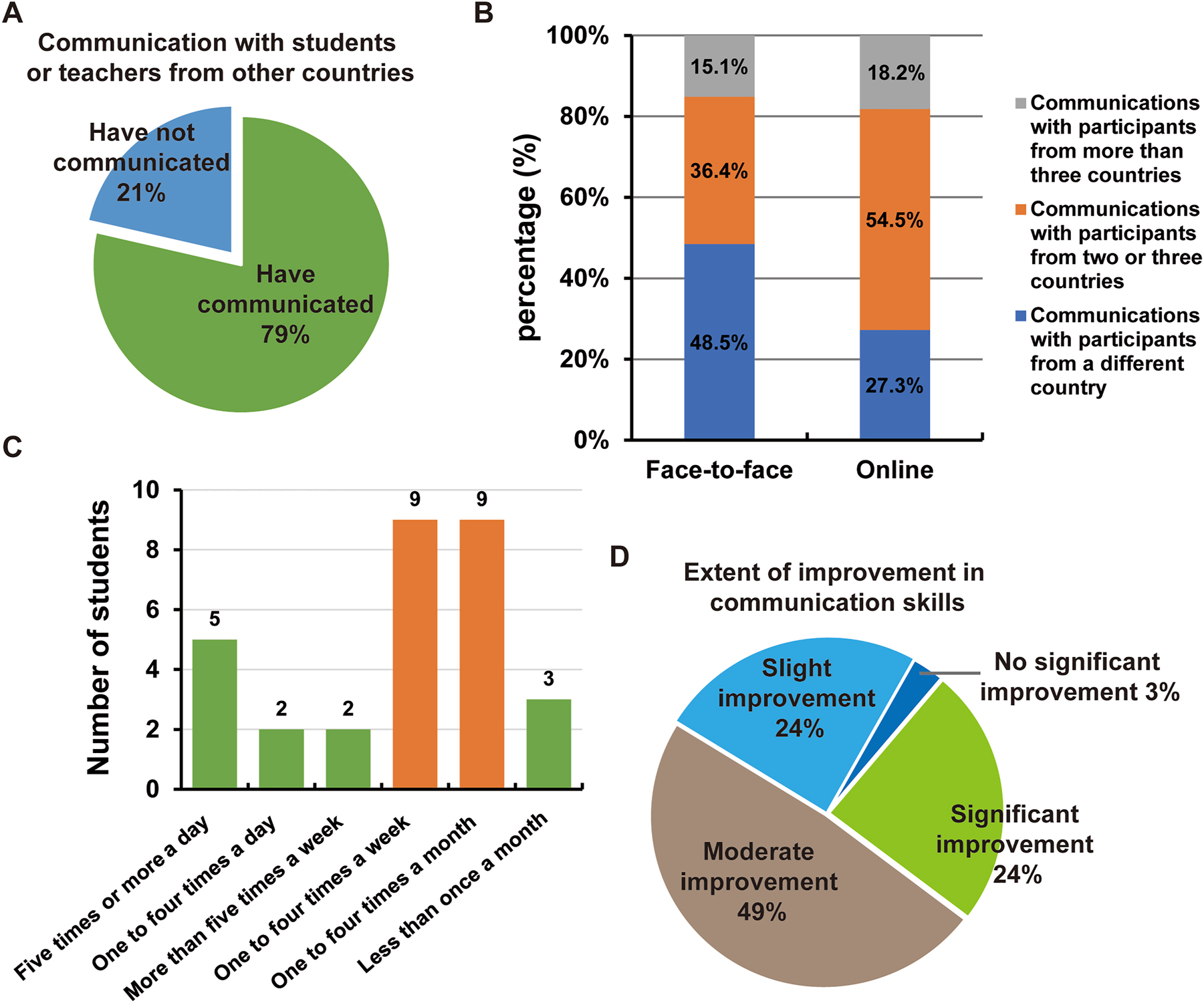
Improvement in the communication skills of students after participating in the GCP projects. (A) Communication experience of students during the GCP projects. (B) The diversity of communication experience of students during the GCP projects, including face-to-face communication and online communication. (C) The frequency of communication of students during the GCP projects. (D) Evaluation of the extent of improvement in communication skills after the GCP projects. The percentage in (A), (B), and (D) indicates the proportion of the students who chose the corresponding option among all students surveyed.
Interdisciplinary collaboration
Interdisciplinary collaboration is one of the key characteristics of OH. The development of students’ interdisciplinary collaboration skills through the GCP projects was assessed in the section on interdisciplinary collaboration of the questionnaire. During the GCP projects, interdisciplinary collaboration among participants was frequent. As shown in Figure 5A, benefiting from the diverse disciplines of the participants (Figure 2C–E), nearly all students (97.3 %) collaborated with teachers or students from two or more different disciplines. It was found that more than half of the students (63.9 %) actively engaged in interdisciplinary collaboration with participants from various disciplines more than 5 times per week (Figure 5B). This indicates that, on average, each student had the opportunity to engage in daily interdisciplinary discussions on complex health issues during the GCP projects. When asked the question “How did collaborating with students from different academic backgrounds enhance your understanding of practical OH issues?”, 72.0 % of students agreed that the interdisciplinary collaboration significantly improved their understanding of practical OH issues (Figure 5C). Likewise, three-fourths of the students (74.0 %) believed that the interdisciplinary nature of the GCP projects notably contributed to their deep thinking and analysis of the complex OH issues (Figure 5D).
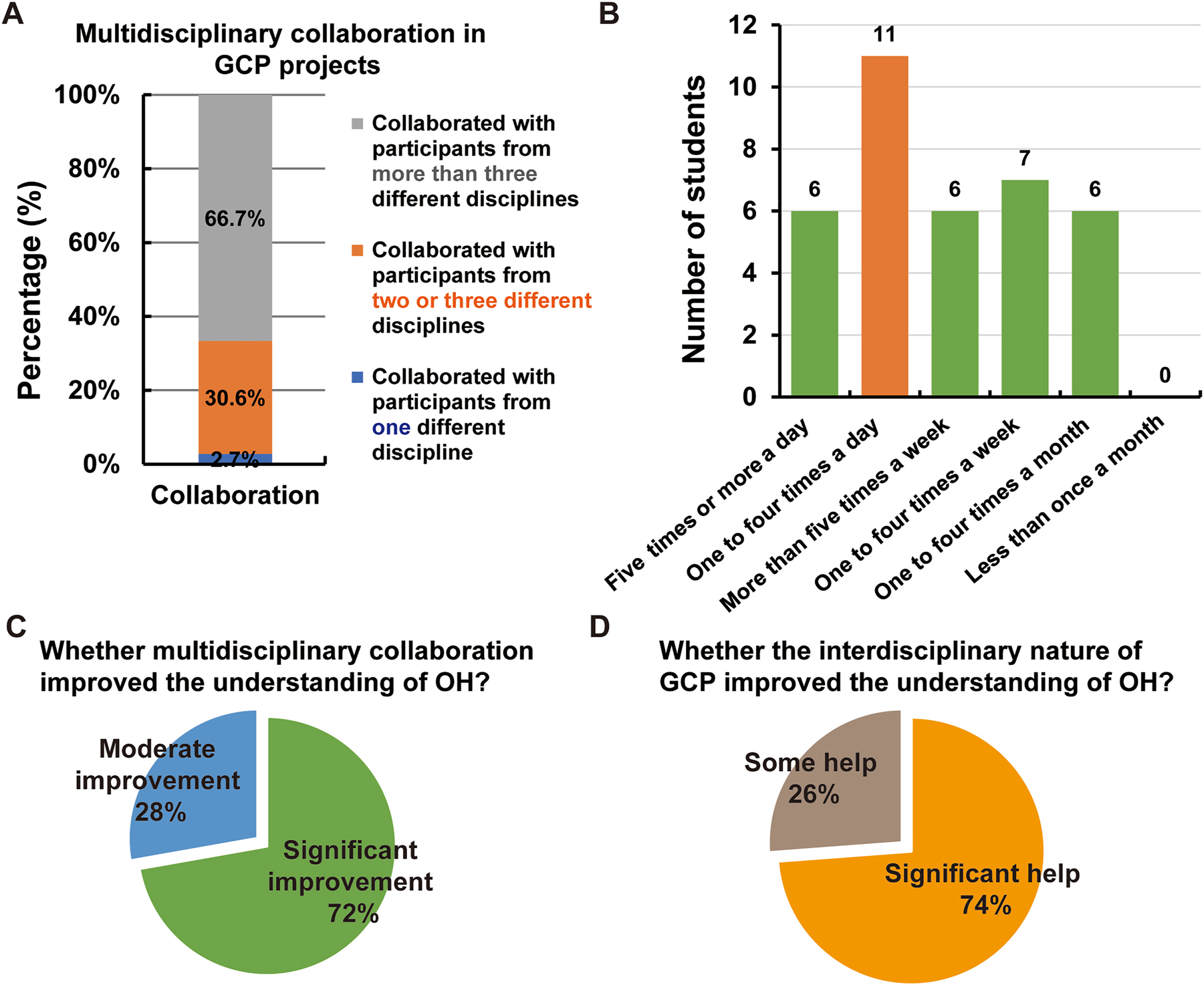
Evaluation of students’ interdisciplinary collaboration abilities cultivated by the GCP projects. (A) The interdisciplinary collaboration experience of students during the GCP projects. (B) The frequency of interdisciplinary collaboration of students during the GCP projects. (C&D) The students’ recognition of the improvement in their understanding of OH through interdisciplinary collaboration. The percentage in (A), (C), and (D) indicates the proportion students who chose the corresponding option among all students.
Achievements of GCP projects
Over the past three years, the GCP projects have received significant recognition and have been honored with numerous collective and individual accolades. The GCP projects have won the Third Prize in the “Zhixing Cup” Shanghai College Students’ Social Practice Competition, as well as the Third Prize in the Shanghai Jiao Tong University Social Practice Competition. Additionally, four faculty advisors and six students have been awarded the titles of “Outstanding Social Practice Advisor” and “Advanced Individual”, respectively, by Shanghai Jiao Tong University.
Discussion
To our knowledge, the GCP projects supported by SJTU might be the first international practice project attempt made by Chinese academic institutions to develop OH education programs based on concrete field research. These GCP projects have been successfully conducted for three years. Each year, the GCP project focuses on analyzing and addressing one complex health issue (especially emerging and re-emerging infectious diseases or zoonosis) through theoretical study and on-site field research utilizing the OH concept and approach. As an important component of the OH education program at SJTU, the GCP projects have gradually become a cornerstone for OH professionals, playing a vital role in enhancing their core competencies. According to the results from our questionnaire survey, the GCP projects have contributed to enhancing students’ OH core competencies from the following three aspects.
Enhancing the competency in systems thinking
Each GCP project focuses on one specific health issue, studying the feasibility of translation of Chinese experience to other countries and regions, which in design allows students to concentrate on and thoroughly analyze a single complex health issue comprehensively. During the GCP projects, students fully realized the necessity and importance of the OH concept and approach in addressing complex health issues. They learned to analyze and solve health issues from the human-animal-ecosystem perspectives and adopted these approaches effectively. For example, after the on-site investigation in GCP-2023, students summarized the main challenges of malaria elimination at the Nong District in Laos, encompassing both natural factors (like humid climate and diverse mosquito species) and human factors (like agricultural laboring modes).
Enhancing the competency in international communication
The cultivation of international communication ability is one of the key and challenging aspects of OH education programs. The GCP projects provide participating students with abundant opportunities to communicate with international experts, researchers, and organizers throughout three parts (theoretical study, field research, and output delivery) of the project. Additionally, the on-site investigation and visits with local individuals not only improved students’ language proficiency and communication skills but also broadened their global perspective and cultural sensitivity and awareness. We found the major obstacles faced by students in international communication during the GCP projects were language barriers and cultural differences (Figure 6A). Therefore, training on basic language and cultural sensitivity should be included in future GCP projects.
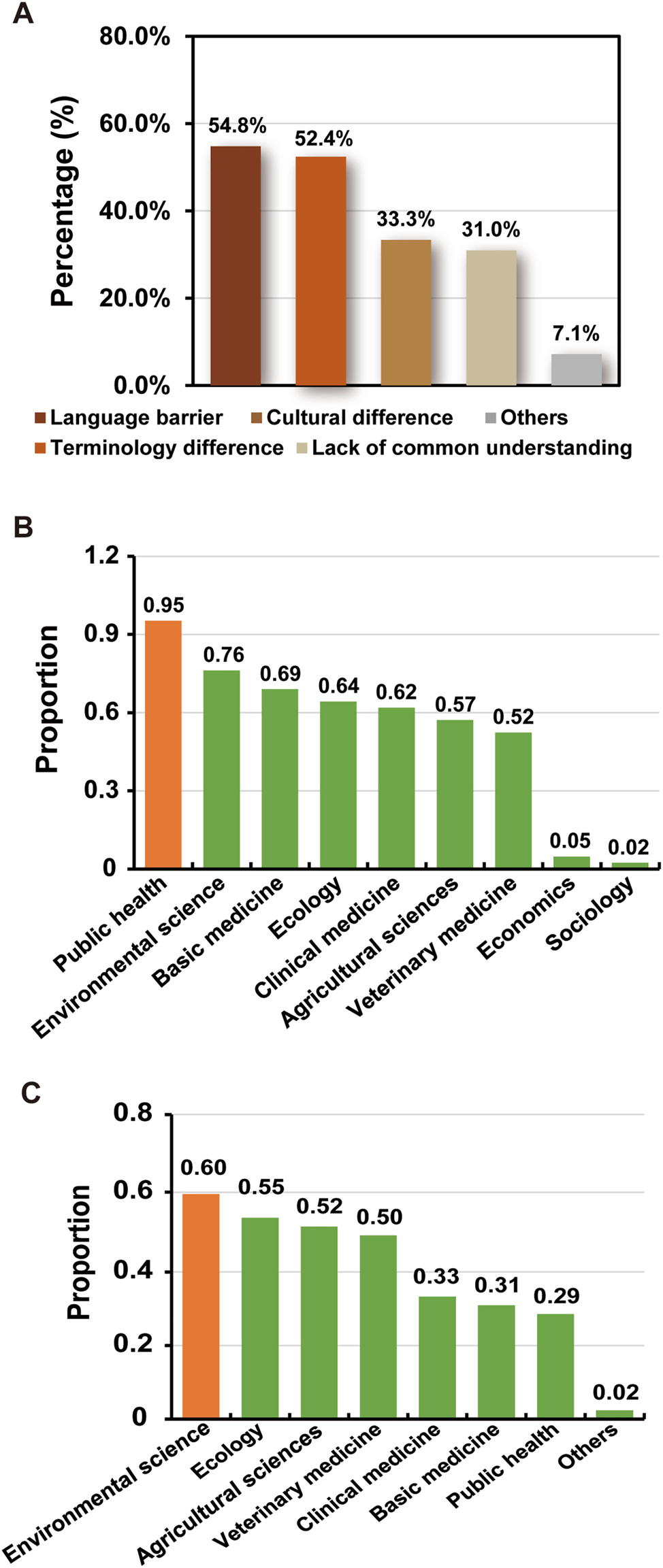
The challenges that students faced during the GCP projects, as well as their advice on the GCP projects. (A) The feedback from students when they were asked the multiple-choice question regarding the biggest obstacles encountered during communication in GCP projects. (B) The feedback from students when they were asked the multiple-choice question “which disciplinary knowledge is important when analyzing OH issues during the GCP projects”. (C) The feedback from students when they were asked the multiple-choice question “which disciplinary knowledge is lacking when analyzing OH issues during the GCP projects”.
Enhancing competency in interdisciplinary collaboration
The diverse academic profiles of student participants in GCP projects have greatly enhanced the extensive and profound interdisciplinary collaboration. By collaborating with others from different origins and educational backgrounds, students were challenged to think about the most effective ways to share knowledge and combine their expertise. Through the GCP projects, students were exposed to diverse perspectives, approaches, and expertise, which not only broadened their understanding of complex health issues but also strengthened their ability to integrate knowledge and information to address these issues comprehensively.
After participating in the GCP projects, students reported high recognition that interdisciplinary collaboration is central to solving complex health issues with the OH approach. They acknowledged that multiple disciplines such as public health, environmental science, basic medicine, ecology, and clinical medicine, play important roles in the implementation of the OH approach (Figure 6B). Moreover, according to the feedback from students who were asked by the question “Which disciplinary knowledge is lacking when analyzing OH issues during the GCP projects,” it was perceived that additional knowledge in environmental science, ecology, agricultural sciences, and veterinary medicine should be included (Figure 6C). This indicated that the GCP projects should recruit more students or invite more experts majoring in the above disciplines in the future to enhance the knowledge network for better analysis and understanding of complex health issues.
Suggestions for the future GCP projects
The evaluation questionnaire in this study (questions 2.10 to 2.12) also provided valuable insights into the GCP projects. Almost all of the students interviewed suggested reducing the number of online lectures and compressing the time of theoretical study. On the contrary, two-thirds of the students expressed the expectation for an increase in field experience and investigations, both domestically and internationally. In addition, one-fourth of the students pointed out that laboratory training and data analysis skills should be included into the GCP projects. Cultural exchange activities and knowledge dissemination skill trainings are also recommended to be incorporated into the projects. Furthermore, upon engaging in the GCP projects, students also aspire to deliver academic outcomes, including publications, patents, policy briefs, etc. Therefore, future GCP projects will focus on enhancing laboratory skill training, data analysis, and local cultural investigations, while reduce theoretical lectures online. Additionally, we intend to develop specific scientific topics and research proposals to facilitate the attainment of more quantifiable academic outcomes.
Conclusions
The GCP projects have yielded positive outcomes in equipping participants with OH core competencies including interdisciplinary skills, teamwork spirit, and problem-solving abilities through systems thinking at the human-animal-environment interface. Valuable insights have been obtained through the implementation of the projects in crafting OH participatory education program. In the future, SJTU will continue to carry out GCP projects targeting various health issues. Additionally, SJTU will actively engage in partnerships with domestic and international universities to further enhance the depth and width of project scope, aiming to set a benchmark for global OH projects. It is recommended to ensure the enduring impact of such projects by expanding and integrating OH education into the medical education system, thereby establishing a sustainable pool of OH talents and resources.
Funding source: International Joint Laboratory on Tropical Diseases Control in Greater Mekong Subregion
Award Identifier / Grant number: 21410750200
Funding source: Shanghai Eastern Talent Plan Leading Project
Award Identifier / Grant number: 2023
-
Research ethics: The local Institutional Review Board deemed the study exempt from review.
-
Author contributions: Study conception design: QH, XZ, ZW; data collection, data analysis and interpretation of results: QH, XZ, LH, LX, XL, XY and SW; Supervision: XZ; Writing-original draft: QH; Writing- review & editing: XZ, LH and ZW.
-
Competing interests: Xiaonong Zhou and Zhaojun Wang are the Deputy Editors-in-Chief of the journal Global Medical Education. They were not involve in the peer review or handling of this manuscript. The authors have no other competing interests to disclose.
-
Research funding: This work was supported by International Joint Laboratory on Tropical Diseases Control in Greater Mekong Subregion [grant number 21410750200].
-
Data availability: Not applicable.
References
1. Holmes, EC. COVID-19-lessons for zoonotic disease. Science 2022;375:1114–5. https://doi.org/10.1126/science.abn2222.Search in Google Scholar PubMed
2. World Health Organization. Tripartite and UNEP support OHHLEP’s definition of “One Health” [Online]. Available from: https://www.who.int/news/item/01-12-2021-tripartite-and-unep-support-ohhlep-s-definition-of-one-health [Accessed 1 Dec 2021].Search in Google Scholar
3. Lerner, H, Berg, C. The concept of health in One Health and some practical implications for research and education: what is One Health? Infect Ecol Epidemiol 2015;5:25300. https://doi.org/10.3402/iee.v5.25300.Search in Google Scholar PubMed PubMed Central
4. Stroud, C, Kaplan, B, Logan, JE, Gray, GC. One Health training, research, and outreach in North America. Infect Ecol Epidemiol 2016;6:33680. https://doi.org/10.3402/iee.v6.33680.Search in Google Scholar PubMed PubMed Central
5. Kahn, LH, Kaplan, B, Monath, TP, Steele, JH. Teaching "one medicine, one health. Am J Med 2008;121:169–70. https://doi.org/10.1016/j.amjmed.2007.09.023.Search in Google Scholar PubMed PubMed Central
6. Moneer, O, Miller, JE, Shah, ND, Ross, JS. Direct-to-consumer personal genomic tests need better regulation. Nat Med 2021;27:940–3. https://doi.org/10.1038/s41591-021-01368-9.Search in Google Scholar PubMed
7. Scott, J. Medical student in global health-just one part of a larger commitment. Acad Med 2013;88:1596–7. https://doi.org/10.1097/acm.0b013e3182a705d1.Search in Google Scholar
8. Kahn, LH. The need for one health degree programs. Infect Ecol Epidemiol 2011;1:7919. https://doi.org/10.3402/iee.v1i0.7919.Search in Google Scholar PubMed PubMed Central
9. Rabinowitz, PM, Natterson-Horowitz, BJ, Kahn, LH, Kock, R, Pappaioanou, M. Incorporating one health into medical education. BMC Med Educ 2017;17:45. https://doi.org/10.1186/s12909-017-0883-6.Search in Google Scholar PubMed PubMed Central
10. Iatridou, D, Bravo, A, Saunders, J. One Health interdisciplinary collaboration in veterinary education establishments in europe: mapping implementation and reflecting on promotion. J Vet Med Educ 2021;48:427–40. https://doi.org/10.3138/jvme-2020-0019.Search in Google Scholar PubMed
11. Courtenay, M, Sweeney, J, Zielinska, P, Blake, SB, La Ragione, R. One Health: an opportunity for an interprofessional approach to healthcare. J Interprof Care 2015;29:641–2. https://doi.org/10.3109/13561820.2015.1041584.Search in Google Scholar PubMed
12. Barrett, MA, Bouley, TA, Stoertz, AH, Stoertz, RW. Integrating a One Health approach in education to address global health and sustainability challenges. Front Ecol Environ 2010;9:239–45. https://doi.org/10.1890/090159.Search in Google Scholar
13. Allen-Scott, LK, Buntain, B, Hatfield, JM, Meisser, A, Thomas, CJ. Building capacity for transdisciplinary research approaches to address complex health issues at the animal-human-ecosystem interface. Acad Med 2015;90:866–71. https://doi.org/10.1097/acm.0000000000000639.Search in Google Scholar
14. Frankson, R, Hueston, W, Christian, K, Olson, D, Lee, M, Valeri, L, et al.. One Health core competency domains. Front Public Health 2016;4:192. https://doi.org/10.3389/fpubh.2016.00192.Search in Google Scholar PubMed PubMed Central
15. Togami, E, Behravesh, CB, Dutcher, TV, Hansen, GR, King, LJ, Pelican, KM, et al.. Characterizing the One Health workforce to promote interdisciplinary, multisectoral approaches in global health problem-solving. PLoS One 2023;18:e0285705. https://doi.org/10.1371/journal.pone.0285705.Search in Google Scholar PubMed PubMed Central
16. Rocheleau, JP, Aenishaenslin, C, Boisjoly, H, Richard, L, Zarowsky, C, Zinszer, K, et al.. Clarifying core competencies in One Health doctoral education: the central contribution of systems thinking. One Earth 2022;5:311–5. https://doi.org/10.1016/j.oneear.2022.03.005.Search in Google Scholar
17. Villanueva-Cabezas, JP, Winkel, KD, Campbell, PT, Wiethoelter, A, Pfeiffer, C. One Health education should be early, inclusive, and holistic. Lancet Planet Health 2022;6:e188–9. https://doi.org/10.1016/s2542-5196(22)00018-3.Search in Google Scholar
18. Berrian, AM, Smith, MH, van Rooyen, J, Martínez-López, B, Plank, MN, Smith, WA, et al.. A community-based One Health education program for disease risk mitigation at the human-animal interface. One Health 2017;5:9–20. https://doi.org/10.1016/j.onehlt.2017.11.002.Search in Google Scholar PubMed PubMed Central
19. Bolon, I, Mason, J, O’Keeffe, P, Haeberli, P, Adan, HA, Karenzi, JM, et al.. One Health education in Kakuma refugee camp (Kenya): from a MOOC to projects on real world challenges. One Health 2020;10:100158. https://doi.org/10.1016/j.onehlt.2020.100158.Search in Google Scholar PubMed PubMed Central
20. Dykstra, MP, Baitchman, EJ. A call for One Health in medical education: how the COVID-19 pandemic underscores the need to integrate human, animal, and environmental health. Acad Med 2021;96:951–3. https://doi.org/10.1097/acm.0000000000004072.Search in Google Scholar PubMed
21. Li, Y, Jin, Z, Dong, G, Zheng, R, Wang, T. A survey of college students’ willingness to participate in social practice with perceived environmental support based on the applied mixed research method. Front Psychol 2022;8:972556. https://doi.org/10.3389/fpsyg.2022.972556.Search in Google Scholar PubMed PubMed Central
22. Haxton, E, Lindberg, A, Troell, K, Redican, KJ. One Health education meets science. Infect Ecol Epidemiol 2015;5:30264. https://doi.org/10.3402/iee.v5.30264.Search in Google Scholar PubMed PubMed Central
23. Gyles, C. One medicine, one health, one world. Can Vet J 2016;57:345–6.Search in Google Scholar
24. Wu, C, Astbury, CC, Lee, KM, Gong, Z, Chen, S, Li, A, et al.. Public awareness of one health in China. One Health 2023;17:100603. https://doi.org/10.1016/j.onehlt.2023.100603.Search in Google Scholar PubMed PubMed Central
Supplementary Material
This article contains supplementary material (https://doi.org/10.1515/gme-2024-0004).
© 2024 the author(s), published by De Gruyter on behalf of the Shanghai Jiao Tong University and the Shanghai Jiao Tong University School of Medicine
This work is licensed under the Creative Commons Attribution 4.0 International License.
Articles in the same Issue
- Frontmatter
- Editorial
- Evolving landscapes in global medical education: navigating challenges and embracing innovation
- Review Articles
- Embarking on the era in new medicine: reshaping the systems of medical education and knowledge
- Aligning the education of medical students to healthcare in the UK
- Characteristics and considerations of French medical education
- Research Articles
- “Global challenge program” projects themed on preventing zoonosis: developing One Health core competences in medical students at SJTU
- Innovative exploration of designing the ‘Host Defense and Immunology’ course based on the concept of seamless learning
- Comparing the effects of blended learning and traditional instruction on “Medical Genetics and Embryonic Development” in undergraduate medical students: a randomized controlled trial
- The application of the “PICO” teaching model in clinical research course for medical students
- Factors bridging medical graduate students’ training and future academic achievements of dermatologists in China
- The teaching design and implementation of “Helicobacter pylori” in medical microbiology
Articles in the same Issue
- Frontmatter
- Editorial
- Evolving landscapes in global medical education: navigating challenges and embracing innovation
- Review Articles
- Embarking on the era in new medicine: reshaping the systems of medical education and knowledge
- Aligning the education of medical students to healthcare in the UK
- Characteristics and considerations of French medical education
- Research Articles
- “Global challenge program” projects themed on preventing zoonosis: developing One Health core competences in medical students at SJTU
- Innovative exploration of designing the ‘Host Defense and Immunology’ course based on the concept of seamless learning
- Comparing the effects of blended learning and traditional instruction on “Medical Genetics and Embryonic Development” in undergraduate medical students: a randomized controlled trial
- The application of the “PICO” teaching model in clinical research course for medical students
- Factors bridging medical graduate students’ training and future academic achievements of dermatologists in China
- The teaching design and implementation of “Helicobacter pylori” in medical microbiology

